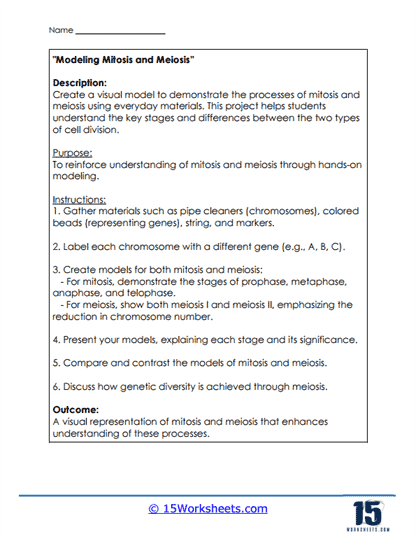Modeling Mitosis and Meiosis

Worksheet Description
Create a visual model to demonstrate the processes of mitosis and meiosis using everyday materials. This project helps students understand the key stages and differences between the two types of cell division. To reinforce understanding of mitosis and meiosis through hands-on modeling.
The aim is to help learners comprehend the distinct stages and disparities between these two fundamental types of cell division. The project encompasses the gathering of materials, constructing models that symbolize various phases, presenting the models while elucidating each stage, and then contrasting the two processes. The worksheet concludes by prompting students to discuss the role of meiosis in promoting genetic diversity.
To execute this project, students should commence by collecting materials such as pipe cleaners, colored beads, string, and markers, each representing different cellular components. Subsequently, they should craft models to depict the stages of both mitosis and meiosis, paying keen attention to details like chromosome number changes and key stage distinctions. Once the models are crafted, students should prepare a brief presentation explaining the significance of each stage and highlighting the differences between mitosis and meiosis. Lastly, they will engage in a discussion or reflection on the importance of meiosis in generating genetic diversity.
The primary intention of this worksheet is to instill a tangible understanding of the intricacies of mitosis and meiosis in students. By encouraging hands-on modeling, the worksheet aims to translate complex cellular concepts into accessible, visual representations, making the learning process more interactive and engaging. This experiential approach not only deepens comprehension but also fosters skills like creativity, critical thinking, and effective communication. Ultimately, learners should be able to differentiate between mitosis and meiosis, recognize their significance, and appreciate the broader implications of these processes in biological contexts.
